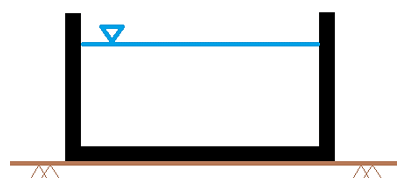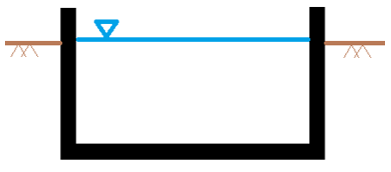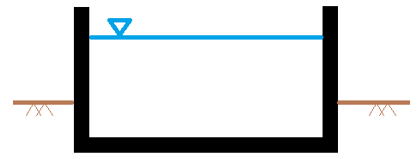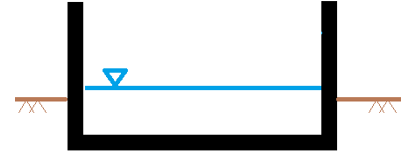This set of Engineering Hydrology Multiple Choice Questions & Answers (MCQs) focuses on “Evaporimeters – Set 3”.
1. Which of the following figures represents the correct placement and usage of the Colorado Sunken pan?
a) 
b) 
c) 
d) 
View Answer
Explanation: The Colorado sunken pan is positioned by burying it into the ground within 100mm from the top surface. The water is filled upto the mark where it is almost equal to the ground level.
2. Which of the following is not a disadvantage of a floating evaporation pan?
a) High installation cost
b) Impact of wave action
c) Difficulty in taking readings
d) Low maintenance cost
View Answer
Explanation: The provision of diagonal baffles in the pan somewhat reduce the surging effect due to wave action but it still causes a problem. The other disadvantages of a floating pan are its high installation and maintenance costs and difficulty in taking measurements and observing readings.
3. Three evaporation pans R, S and T of diameters 1 m, 1.5 m and 2 m respectively ae used for predicting evaporation of a nearby lake. Which pan is expected to give the more reliable readings?
a) Pan R
b) Pan S
c) Pan T
d) Cannot be determined
View Answer
Explanation: The evaporation readings from a pan depends on its size to some extent because of the differing heat storage and transfer capacity. The larger pan will give a value which will be closer to actual value of a nearby lake.
4. Which of the following evaporimeters gives the highest evaporation readings for the same area?
a) Class A land pan
b) ISI pan
c) Colorado sunken pan
d) USGS floating pan
View Answer
Explanation: Due to the different specifications of each pan, they give different evaporation readings for the same area. The Class A pan has a pan coefficient range of 0.6 to 0.8 and an average value of 0.7 which is the least among the evaporimeters. Given actual lake evaporation is constant, the pan coefficient varies inversely with the pan evaporation. Hence, the class A pan will have the highest evaporation.
5. Which of the following expressions is the correct one for pan coefficient (Cp)?
a) Lake evaporation*Pan evaporation
b) Pan evaporation-Lake evaporation
c) \(\frac{Pan \, evaporation}{Lake \, evaporation} \)
d) \(\frac{Lake \, evaporation}{Pan \, evaporation} \)
View Answer
Explanation: Due to the inevitable limitations of using an evaporimeter to estimate the evaporation from a water body, the observed values have to be corrected to get the value for lake evaporation under similar conditions. This is done by introducing a term called pan coefficient (Cp) which is to be multiplied by the pan evaporation to get the required lake evaporation.
6. A Class A evaporation pan of 250 mm depth is used to conduct an evaporation experiment. It is used in four different cases to predict the evaporation. Which of the following cases will give the least evaporation values for the same point given all the parameters remain same for the four cases?
a) Pan filled upto rim
b) Pan is half full
c) Pan filled upto 50 mm from rim
d) Pan filled upto 100 mm from rim
View Answer
Explanation: The effect of wind over the water surface is affected by the height of the rim of the pan. The rim also casts a shadow over the water surface depending on the time of the day. So when the pan is half full, it has the largest rim height (125 mm) of the four cases and will give the least evaporation values.
7. A typical hydrometeorological station consists of a recording raingauge, wind anemometer, thermo-hygrograph, river staff gauge and pan evaporimeter among other instruments.
a) True
b) False
View Answer
Explanation: A hydrometeorological station usually consists of ordinary and recording raingauges, Stevenson box with thermometers, wind anemometer and direction indicator, sunshine recorder, thermo-hygrograph and pan evaporimeter.
8. The WMO gives the number the evaporimeter stations in an area based on which of the following?
a) Climate
b) Topography
c) Size
d) Number of water bodies
View Answer
Explanation: The evaporation pans are usually setup in locations where other meteorological data are also readily available. The WMO recommends the number of evaporimeter stations for a region depending on its climate and divides it into three zones – arid, humid temperate and cold regions.
9. An evaporimeter network needs to be setup as per WMO in a region of 1,30,000 km2 area in the Thar desert. How many stations are required?
a) 3
b) 4
c) 5
d) 6
View Answer
Explanation: The Thar desert is a major part of the arid zone of India. As per WMO, arid zones require one evaporation station per 30,000 km2 of area. So for the region under consideration,
No.of stations=\(\frac{Area}{Area per station}=\frac{130000 km^2}{30000 km^2/station}\)=4.33 ≅5 stations
10. As per WMO, how many evaporation stations are required for a 50,000 km2 area in a humid temperate and cold region respectively?
a) 1, 1
b) 1, 2
c) 2, 1
d) 2, 2
View Answer
Explanation: According to WMO recommendations, humid temperate regions require one station for every 50,000 km2, and cold regions require one station for every 1,00,000 km2. So for an area measuring 50,000 km2, the number of evaporation stations would be 1 for both humid temperate and cold regions.
Sanfoundry Global Education & Learning Series – Engineering Hydrology.
To practice all areas of Engineering Hydrology, here is complete set of 1000+ Multiple Choice Questions and Answers.
If you find a mistake in question / option / answer, kindly take a screenshot and email to [email protected]
